Taxation Law Assignment: Sophie, Kate, and Joe - Tax Implications
VerifiedAdded on 2022/10/04
|14
|3476
|23
Homework Assignment
AI Summary
This document presents a detailed analysis of a taxation law assignment, addressing the tax implications for three individuals: Sophie, Kate, and Joe. The assignment explores various scenarios, including the taxation of lump-sum damages for loss of reputation, compensation for loss of income, and reimbursement of legal fees for Sophie. For Kate, the analysis covers the tax consequences of lump-sum payments for pain and suffering, ongoing medical and cosmetic surgery costs, and interest on lump-sum payments. The document references key legal principles established in cases such as Whitaker v FC of T, FC of T v Sydney Refractive Surgery Centre Pty Ltd, and Allied Mills Industries Pty Ltd v Commissioner of Taxation. Additionally, it examines the CGT liabilities and business income considerations for Joe, including the application of relevant tax rulings and the impact of CGT events and main residence exemptions. The assignment provides a comprehensive overview of the tax implications of these scenarios under Australian taxation law.
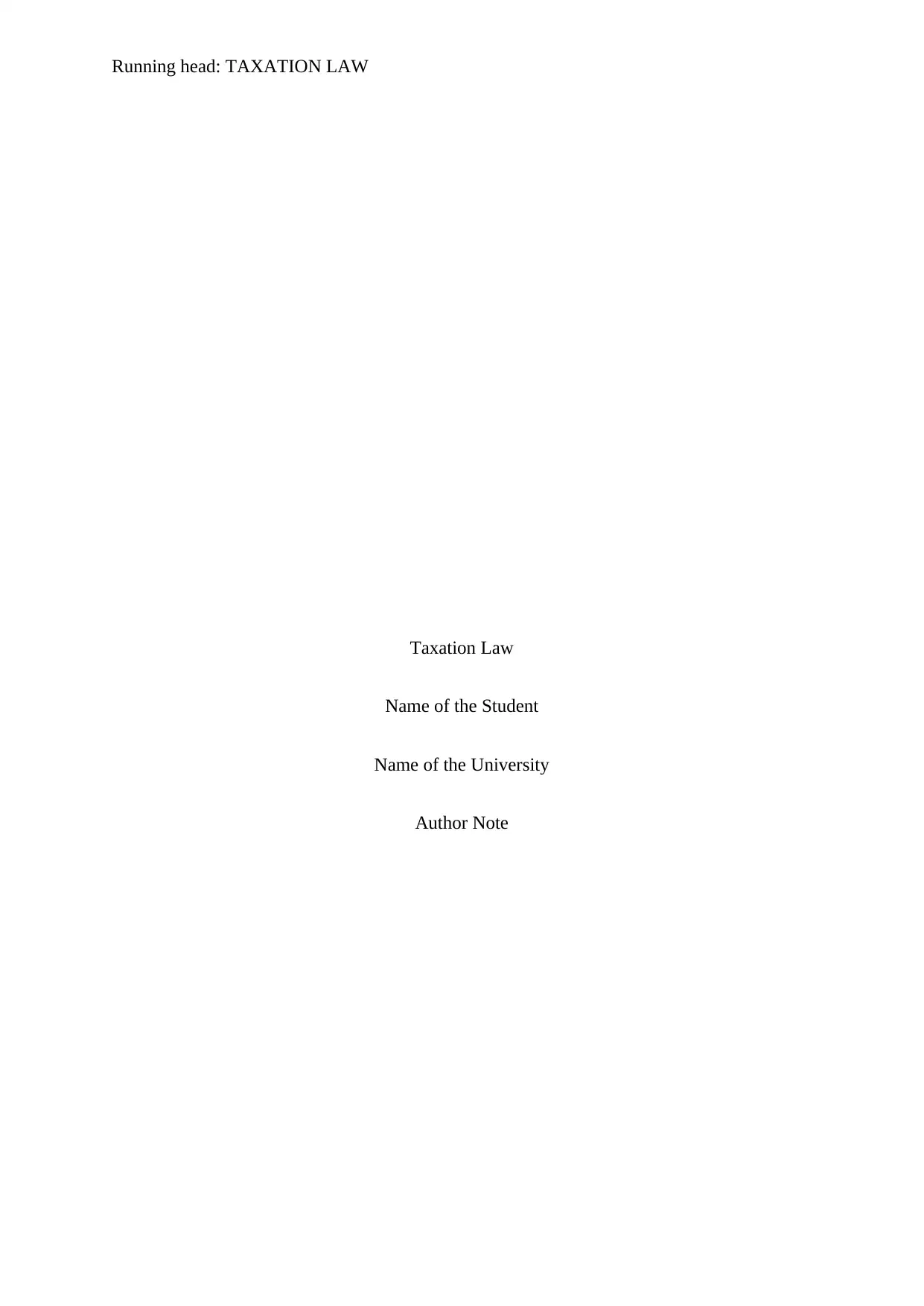
Running head: TAXATION LAW
Taxation Law
Name of the Student
Name of the University
Author Note
Taxation Law
Name of the Student
Name of the University
Author Note
Paraphrase This Document
Need a fresh take? Get an instant paraphrase of this document with our AI Paraphraser
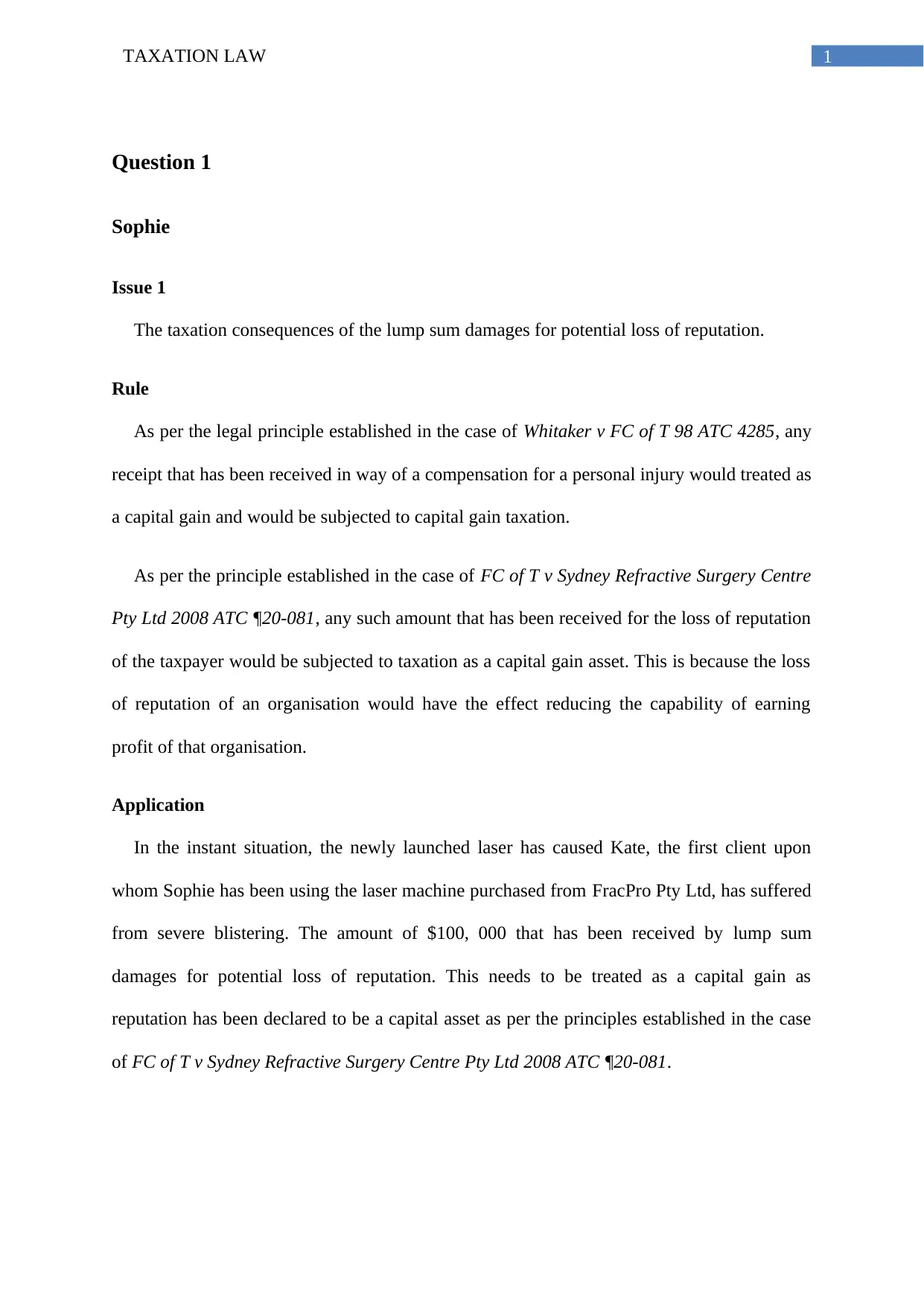
1TAXATION LAW
Question 1
Sophie
Issue 1
The taxation consequences of the lump sum damages for potential loss of reputation.
Rule
As per the legal principle established in the case of Whitaker v FC of T 98 ATC 4285, any
receipt that has been received in way of a compensation for a personal injury would treated as
a capital gain and would be subjected to capital gain taxation.
As per the principle established in the case of FC of T v Sydney Refractive Surgery Centre
Pty Ltd 2008 ATC ¶20-081, any such amount that has been received for the loss of reputation
of the taxpayer would be subjected to taxation as a capital gain asset. This is because the loss
of reputation of an organisation would have the effect reducing the capability of earning
profit of that organisation.
Application
In the instant situation, the newly launched laser has caused Kate, the first client upon
whom Sophie has been using the laser machine purchased from FracPro Pty Ltd, has suffered
from severe blistering. The amount of $100, 000 that has been received by lump sum
damages for potential loss of reputation. This needs to be treated as a capital gain as
reputation has been declared to be a capital asset as per the principles established in the case
of FC of T v Sydney Refractive Surgery Centre Pty Ltd 2008 ATC ¶20-081.
Question 1
Sophie
Issue 1
The taxation consequences of the lump sum damages for potential loss of reputation.
Rule
As per the legal principle established in the case of Whitaker v FC of T 98 ATC 4285, any
receipt that has been received in way of a compensation for a personal injury would treated as
a capital gain and would be subjected to capital gain taxation.
As per the principle established in the case of FC of T v Sydney Refractive Surgery Centre
Pty Ltd 2008 ATC ¶20-081, any such amount that has been received for the loss of reputation
of the taxpayer would be subjected to taxation as a capital gain asset. This is because the loss
of reputation of an organisation would have the effect reducing the capability of earning
profit of that organisation.
Application
In the instant situation, the newly launched laser has caused Kate, the first client upon
whom Sophie has been using the laser machine purchased from FracPro Pty Ltd, has suffered
from severe blistering. The amount of $100, 000 that has been received by lump sum
damages for potential loss of reputation. This needs to be treated as a capital gain as
reputation has been declared to be a capital asset as per the principles established in the case
of FC of T v Sydney Refractive Surgery Centre Pty Ltd 2008 ATC ¶20-081.
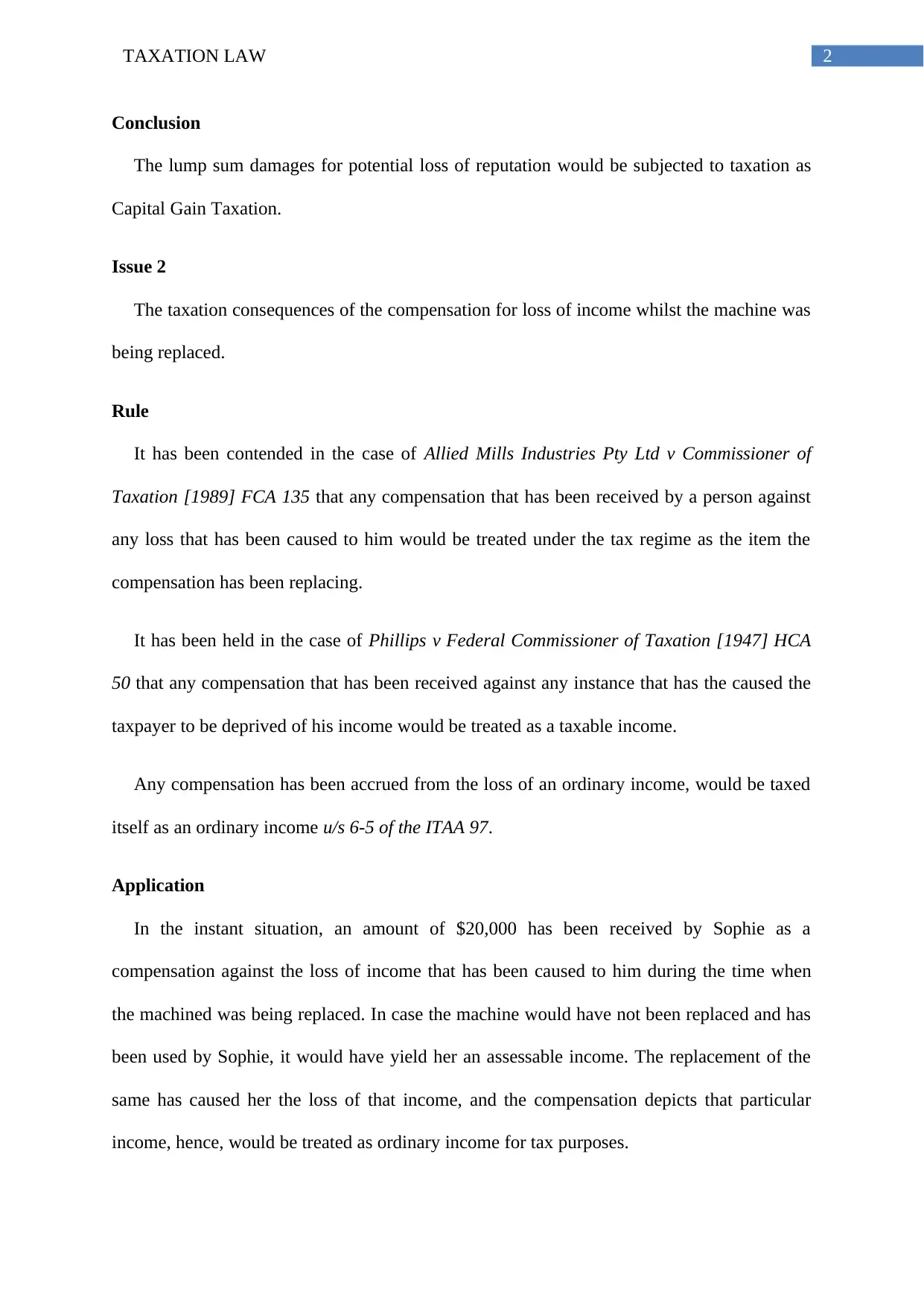
2TAXATION LAW
Conclusion
The lump sum damages for potential loss of reputation would be subjected to taxation as
Capital Gain Taxation.
Issue 2
The taxation consequences of the compensation for loss of income whilst the machine was
being replaced.
Rule
It has been contended in the case of Allied Mills Industries Pty Ltd v Commissioner of
Taxation [1989] FCA 135 that any compensation that has been received by a person against
any loss that has been caused to him would be treated under the tax regime as the item the
compensation has been replacing.
It has been held in the case of Phillips v Federal Commissioner of Taxation [1947] HCA
50 that any compensation that has been received against any instance that has the caused the
taxpayer to be deprived of his income would be treated as a taxable income.
Any compensation has been accrued from the loss of an ordinary income, would be taxed
itself as an ordinary income u/s 6-5 of the ITAA 97.
Application
In the instant situation, an amount of $20,000 has been received by Sophie as a
compensation against the loss of income that has been caused to him during the time when
the machined was being replaced. In case the machine would have not been replaced and has
been used by Sophie, it would have yield her an assessable income. The replacement of the
same has caused her the loss of that income, and the compensation depicts that particular
income, hence, would be treated as ordinary income for tax purposes.
Conclusion
The lump sum damages for potential loss of reputation would be subjected to taxation as
Capital Gain Taxation.
Issue 2
The taxation consequences of the compensation for loss of income whilst the machine was
being replaced.
Rule
It has been contended in the case of Allied Mills Industries Pty Ltd v Commissioner of
Taxation [1989] FCA 135 that any compensation that has been received by a person against
any loss that has been caused to him would be treated under the tax regime as the item the
compensation has been replacing.
It has been held in the case of Phillips v Federal Commissioner of Taxation [1947] HCA
50 that any compensation that has been received against any instance that has the caused the
taxpayer to be deprived of his income would be treated as a taxable income.
Any compensation has been accrued from the loss of an ordinary income, would be taxed
itself as an ordinary income u/s 6-5 of the ITAA 97.
Application
In the instant situation, an amount of $20,000 has been received by Sophie as a
compensation against the loss of income that has been caused to him during the time when
the machined was being replaced. In case the machine would have not been replaced and has
been used by Sophie, it would have yield her an assessable income. The replacement of the
same has caused her the loss of that income, and the compensation depicts that particular
income, hence, would be treated as ordinary income for tax purposes.
⊘ This is a preview!⊘
Do you want full access?
Subscribe today to unlock all pages.

Trusted by 1+ million students worldwide
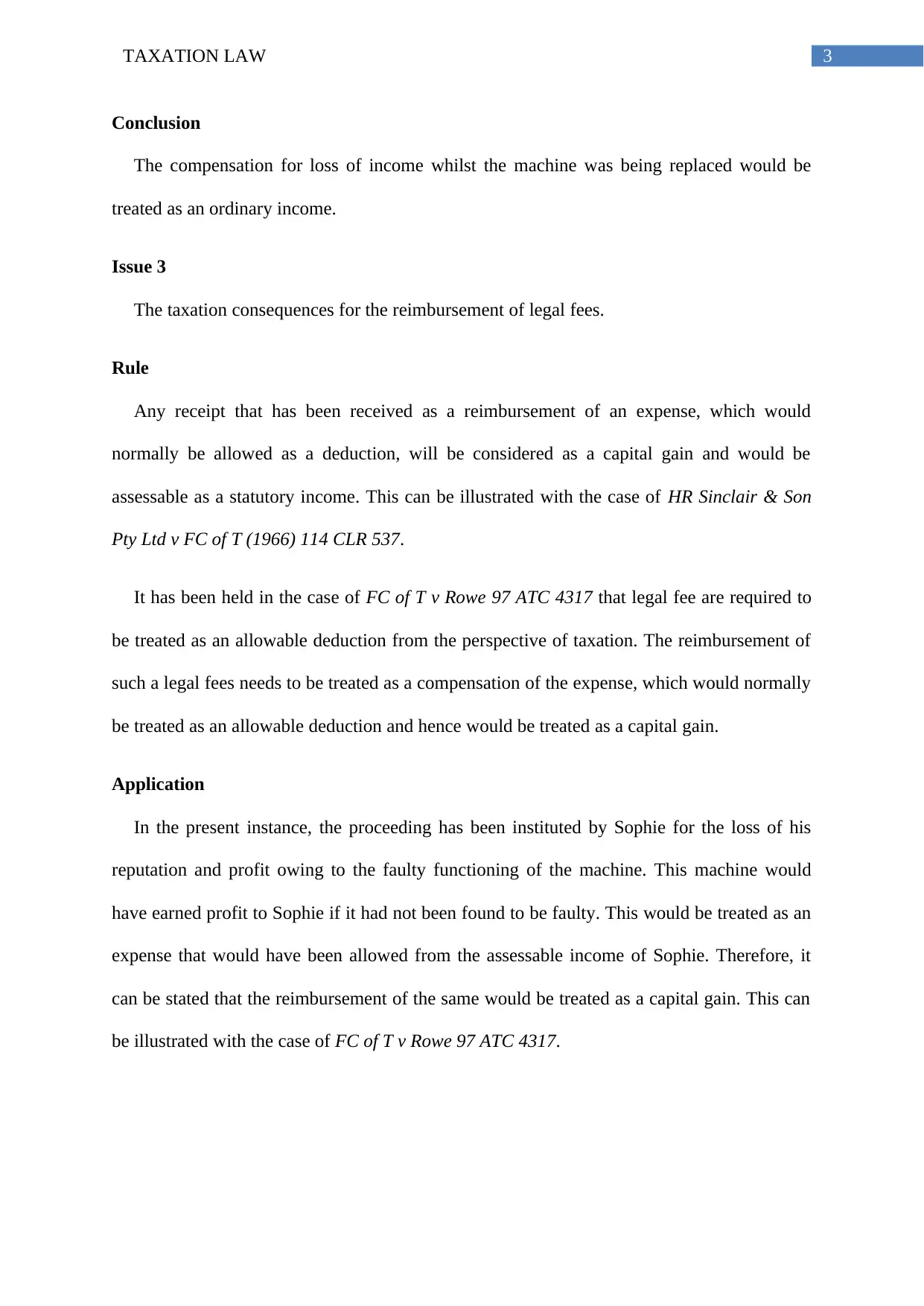
3TAXATION LAW
Conclusion
The compensation for loss of income whilst the machine was being replaced would be
treated as an ordinary income.
Issue 3
The taxation consequences for the reimbursement of legal fees.
Rule
Any receipt that has been received as a reimbursement of an expense, which would
normally be allowed as a deduction, will be considered as a capital gain and would be
assessable as a statutory income. This can be illustrated with the case of HR Sinclair & Son
Pty Ltd v FC of T (1966) 114 CLR 537.
It has been held in the case of FC of T v Rowe 97 ATC 4317 that legal fee are required to
be treated as an allowable deduction from the perspective of taxation. The reimbursement of
such a legal fees needs to be treated as a compensation of the expense, which would normally
be treated as an allowable deduction and hence would be treated as a capital gain.
Application
In the present instance, the proceeding has been instituted by Sophie for the loss of his
reputation and profit owing to the faulty functioning of the machine. This machine would
have earned profit to Sophie if it had not been found to be faulty. This would be treated as an
expense that would have been allowed from the assessable income of Sophie. Therefore, it
can be stated that the reimbursement of the same would be treated as a capital gain. This can
be illustrated with the case of FC of T v Rowe 97 ATC 4317.
Conclusion
The compensation for loss of income whilst the machine was being replaced would be
treated as an ordinary income.
Issue 3
The taxation consequences for the reimbursement of legal fees.
Rule
Any receipt that has been received as a reimbursement of an expense, which would
normally be allowed as a deduction, will be considered as a capital gain and would be
assessable as a statutory income. This can be illustrated with the case of HR Sinclair & Son
Pty Ltd v FC of T (1966) 114 CLR 537.
It has been held in the case of FC of T v Rowe 97 ATC 4317 that legal fee are required to
be treated as an allowable deduction from the perspective of taxation. The reimbursement of
such a legal fees needs to be treated as a compensation of the expense, which would normally
be treated as an allowable deduction and hence would be treated as a capital gain.
Application
In the present instance, the proceeding has been instituted by Sophie for the loss of his
reputation and profit owing to the faulty functioning of the machine. This machine would
have earned profit to Sophie if it had not been found to be faulty. This would be treated as an
expense that would have been allowed from the assessable income of Sophie. Therefore, it
can be stated that the reimbursement of the same would be treated as a capital gain. This can
be illustrated with the case of FC of T v Rowe 97 ATC 4317.
Paraphrase This Document
Need a fresh take? Get an instant paraphrase of this document with our AI Paraphraser
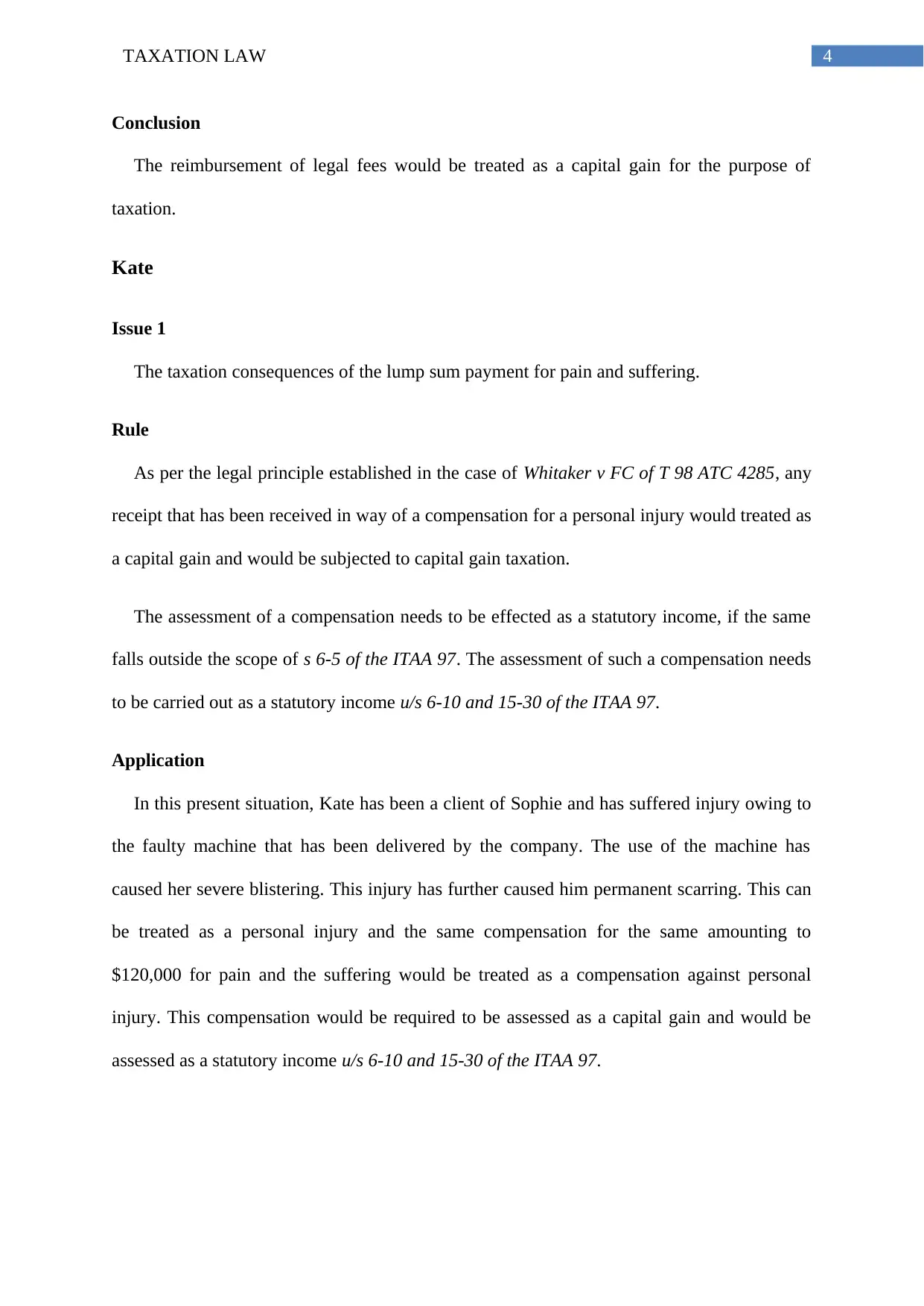
4TAXATION LAW
Conclusion
The reimbursement of legal fees would be treated as a capital gain for the purpose of
taxation.
Kate
Issue 1
The taxation consequences of the lump sum payment for pain and suffering.
Rule
As per the legal principle established in the case of Whitaker v FC of T 98 ATC 4285, any
receipt that has been received in way of a compensation for a personal injury would treated as
a capital gain and would be subjected to capital gain taxation.
The assessment of a compensation needs to be effected as a statutory income, if the same
falls outside the scope of s 6-5 of the ITAA 97. The assessment of such a compensation needs
to be carried out as a statutory income u/s 6-10 and 15-30 of the ITAA 97.
Application
In this present situation, Kate has been a client of Sophie and has suffered injury owing to
the faulty machine that has been delivered by the company. The use of the machine has
caused her severe blistering. This injury has further caused him permanent scarring. This can
be treated as a personal injury and the same compensation for the same amounting to
$120,000 for pain and the suffering would be treated as a compensation against personal
injury. This compensation would be required to be assessed as a capital gain and would be
assessed as a statutory income u/s 6-10 and 15-30 of the ITAA 97.
Conclusion
The reimbursement of legal fees would be treated as a capital gain for the purpose of
taxation.
Kate
Issue 1
The taxation consequences of the lump sum payment for pain and suffering.
Rule
As per the legal principle established in the case of Whitaker v FC of T 98 ATC 4285, any
receipt that has been received in way of a compensation for a personal injury would treated as
a capital gain and would be subjected to capital gain taxation.
The assessment of a compensation needs to be effected as a statutory income, if the same
falls outside the scope of s 6-5 of the ITAA 97. The assessment of such a compensation needs
to be carried out as a statutory income u/s 6-10 and 15-30 of the ITAA 97.
Application
In this present situation, Kate has been a client of Sophie and has suffered injury owing to
the faulty machine that has been delivered by the company. The use of the machine has
caused her severe blistering. This injury has further caused him permanent scarring. This can
be treated as a personal injury and the same compensation for the same amounting to
$120,000 for pain and the suffering would be treated as a compensation against personal
injury. This compensation would be required to be assessed as a capital gain and would be
assessed as a statutory income u/s 6-10 and 15-30 of the ITAA 97.
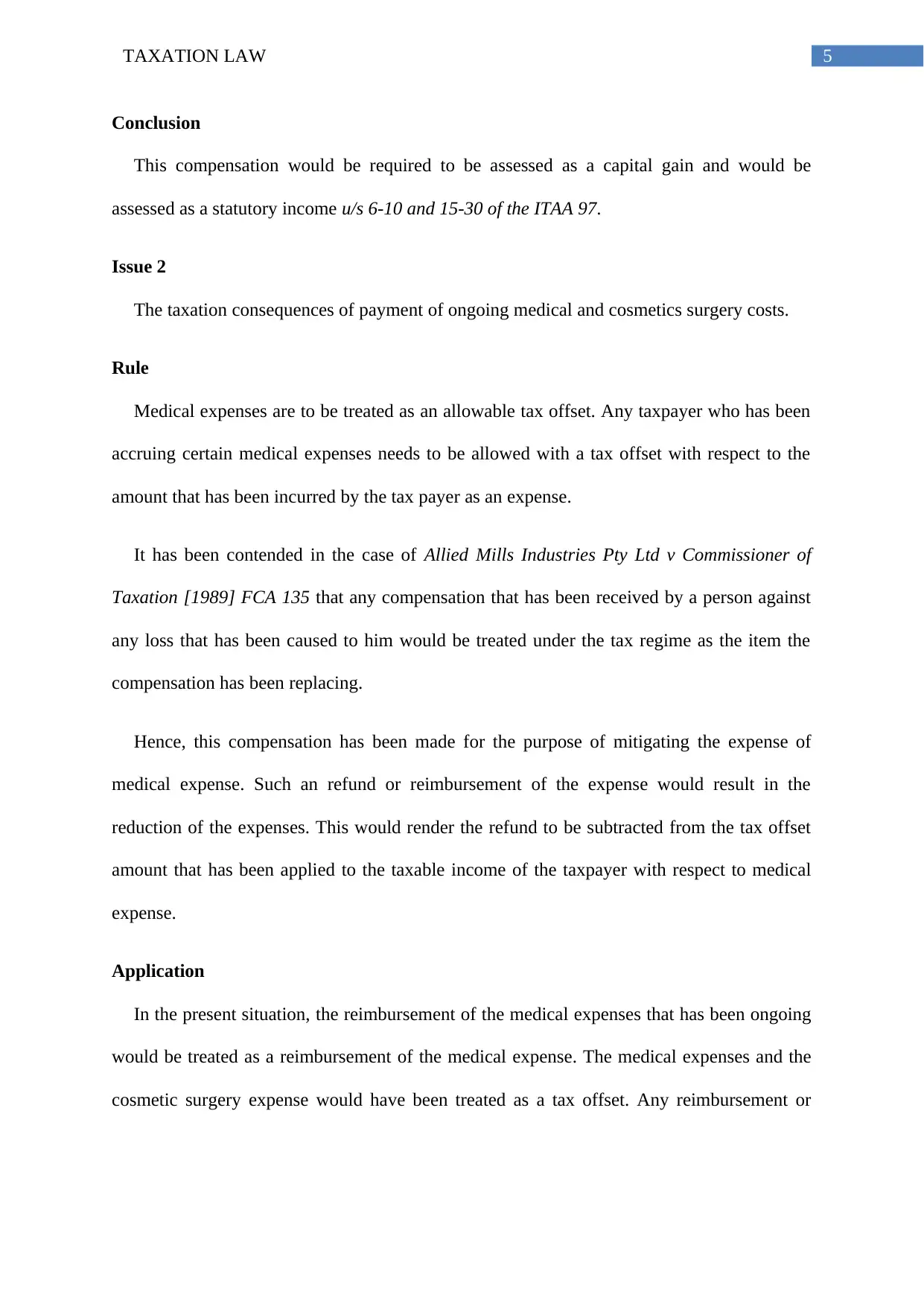
5TAXATION LAW
Conclusion
This compensation would be required to be assessed as a capital gain and would be
assessed as a statutory income u/s 6-10 and 15-30 of the ITAA 97.
Issue 2
The taxation consequences of payment of ongoing medical and cosmetics surgery costs.
Rule
Medical expenses are to be treated as an allowable tax offset. Any taxpayer who has been
accruing certain medical expenses needs to be allowed with a tax offset with respect to the
amount that has been incurred by the tax payer as an expense.
It has been contended in the case of Allied Mills Industries Pty Ltd v Commissioner of
Taxation [1989] FCA 135 that any compensation that has been received by a person against
any loss that has been caused to him would be treated under the tax regime as the item the
compensation has been replacing.
Hence, this compensation has been made for the purpose of mitigating the expense of
medical expense. Such an refund or reimbursement of the expense would result in the
reduction of the expenses. This would render the refund to be subtracted from the tax offset
amount that has been applied to the taxable income of the taxpayer with respect to medical
expense.
Application
In the present situation, the reimbursement of the medical expenses that has been ongoing
would be treated as a reimbursement of the medical expense. The medical expenses and the
cosmetic surgery expense would have been treated as a tax offset. Any reimbursement or
Conclusion
This compensation would be required to be assessed as a capital gain and would be
assessed as a statutory income u/s 6-10 and 15-30 of the ITAA 97.
Issue 2
The taxation consequences of payment of ongoing medical and cosmetics surgery costs.
Rule
Medical expenses are to be treated as an allowable tax offset. Any taxpayer who has been
accruing certain medical expenses needs to be allowed with a tax offset with respect to the
amount that has been incurred by the tax payer as an expense.
It has been contended in the case of Allied Mills Industries Pty Ltd v Commissioner of
Taxation [1989] FCA 135 that any compensation that has been received by a person against
any loss that has been caused to him would be treated under the tax regime as the item the
compensation has been replacing.
Hence, this compensation has been made for the purpose of mitigating the expense of
medical expense. Such an refund or reimbursement of the expense would result in the
reduction of the expenses. This would render the refund to be subtracted from the tax offset
amount that has been applied to the taxable income of the taxpayer with respect to medical
expense.
Application
In the present situation, the reimbursement of the medical expenses that has been ongoing
would be treated as a reimbursement of the medical expense. The medical expenses and the
cosmetic surgery expense would have been treated as a tax offset. Any reimbursement or
⊘ This is a preview!⊘
Do you want full access?
Subscribe today to unlock all pages.

Trusted by 1+ million students worldwide
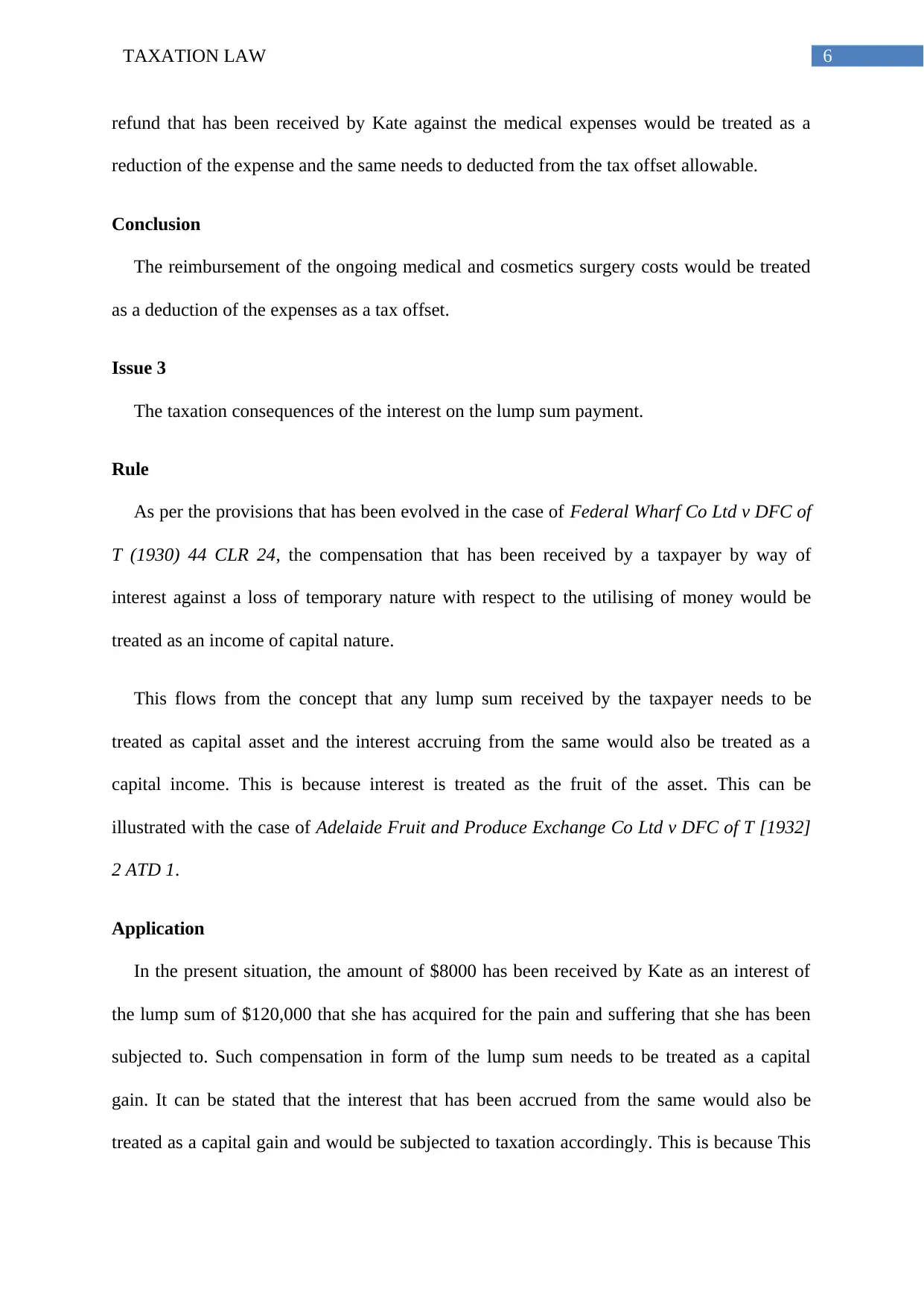
6TAXATION LAW
refund that has been received by Kate against the medical expenses would be treated as a
reduction of the expense and the same needs to deducted from the tax offset allowable.
Conclusion
The reimbursement of the ongoing medical and cosmetics surgery costs would be treated
as a deduction of the expenses as a tax offset.
Issue 3
The taxation consequences of the interest on the lump sum payment.
Rule
As per the provisions that has been evolved in the case of Federal Wharf Co Ltd v DFC of
T (1930) 44 CLR 24, the compensation that has been received by a taxpayer by way of
interest against a loss of temporary nature with respect to the utilising of money would be
treated as an income of capital nature.
This flows from the concept that any lump sum received by the taxpayer needs to be
treated as capital asset and the interest accruing from the same would also be treated as a
capital income. This is because interest is treated as the fruit of the asset. This can be
illustrated with the case of Adelaide Fruit and Produce Exchange Co Ltd v DFC of T [1932]
2 ATD 1.
Application
In the present situation, the amount of $8000 has been received by Kate as an interest of
the lump sum of $120,000 that she has acquired for the pain and suffering that she has been
subjected to. Such compensation in form of the lump sum needs to be treated as a capital
gain. It can be stated that the interest that has been accrued from the same would also be
treated as a capital gain and would be subjected to taxation accordingly. This is because This
refund that has been received by Kate against the medical expenses would be treated as a
reduction of the expense and the same needs to deducted from the tax offset allowable.
Conclusion
The reimbursement of the ongoing medical and cosmetics surgery costs would be treated
as a deduction of the expenses as a tax offset.
Issue 3
The taxation consequences of the interest on the lump sum payment.
Rule
As per the provisions that has been evolved in the case of Federal Wharf Co Ltd v DFC of
T (1930) 44 CLR 24, the compensation that has been received by a taxpayer by way of
interest against a loss of temporary nature with respect to the utilising of money would be
treated as an income of capital nature.
This flows from the concept that any lump sum received by the taxpayer needs to be
treated as capital asset and the interest accruing from the same would also be treated as a
capital income. This is because interest is treated as the fruit of the asset. This can be
illustrated with the case of Adelaide Fruit and Produce Exchange Co Ltd v DFC of T [1932]
2 ATD 1.
Application
In the present situation, the amount of $8000 has been received by Kate as an interest of
the lump sum of $120,000 that she has acquired for the pain and suffering that she has been
subjected to. Such compensation in form of the lump sum needs to be treated as a capital
gain. It can be stated that the interest that has been accrued from the same would also be
treated as a capital gain and would be subjected to taxation accordingly. This is because This
Paraphrase This Document
Need a fresh take? Get an instant paraphrase of this document with our AI Paraphraser
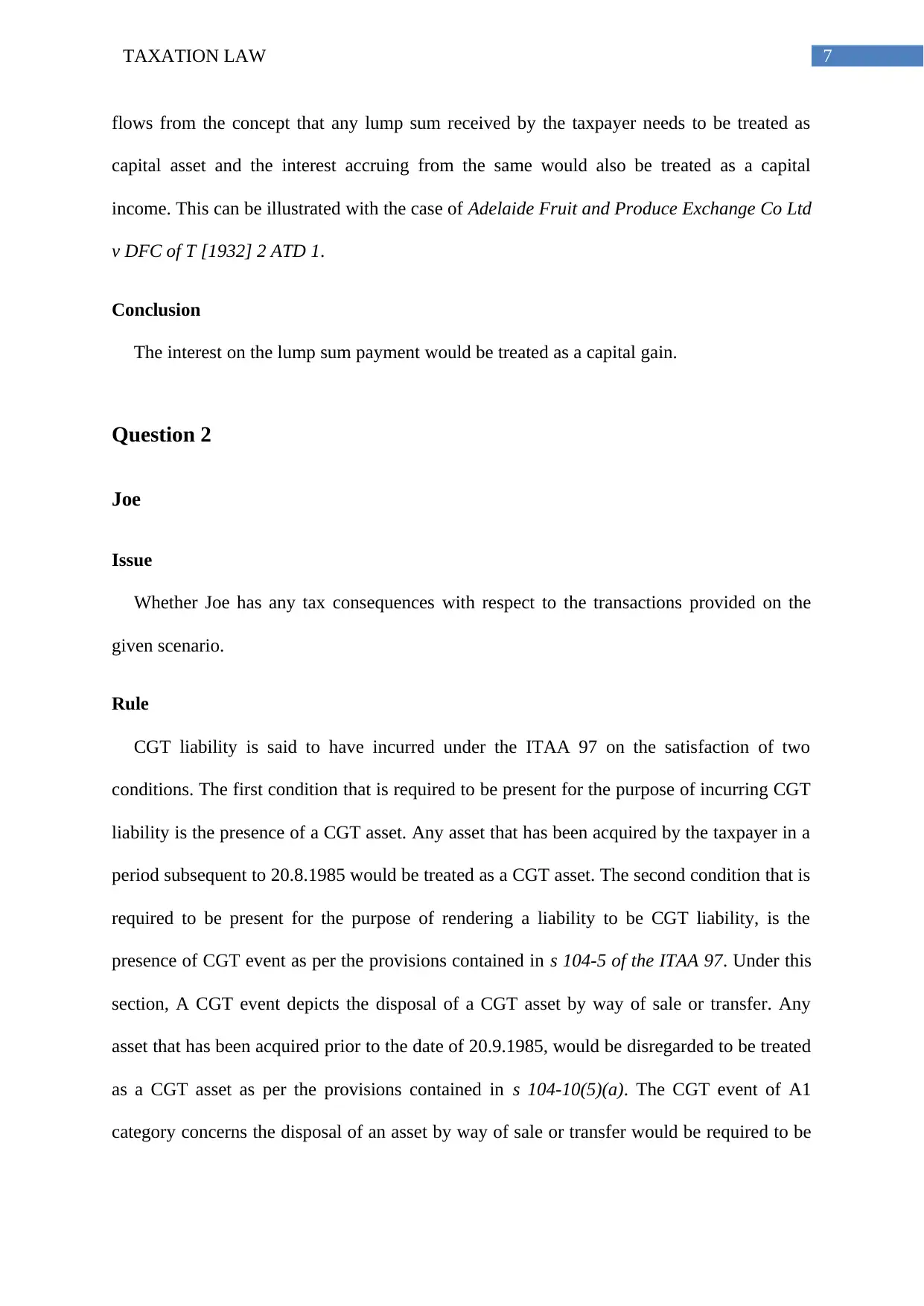
7TAXATION LAW
flows from the concept that any lump sum received by the taxpayer needs to be treated as
capital asset and the interest accruing from the same would also be treated as a capital
income. This can be illustrated with the case of Adelaide Fruit and Produce Exchange Co Ltd
v DFC of T [1932] 2 ATD 1.
Conclusion
The interest on the lump sum payment would be treated as a capital gain.
Question 2
Joe
Issue
Whether Joe has any tax consequences with respect to the transactions provided on the
given scenario.
Rule
CGT liability is said to have incurred under the ITAA 97 on the satisfaction of two
conditions. The first condition that is required to be present for the purpose of incurring CGT
liability is the presence of a CGT asset. Any asset that has been acquired by the taxpayer in a
period subsequent to 20.8.1985 would be treated as a CGT asset. The second condition that is
required to be present for the purpose of rendering a liability to be CGT liability, is the
presence of CGT event as per the provisions contained in s 104-5 of the ITAA 97. Under this
section, A CGT event depicts the disposal of a CGT asset by way of sale or transfer. Any
asset that has been acquired prior to the date of 20.9.1985, would be disregarded to be treated
as a CGT asset as per the provisions contained in s 104-10(5)(a). The CGT event of A1
category concerns the disposal of an asset by way of sale or transfer would be required to be
flows from the concept that any lump sum received by the taxpayer needs to be treated as
capital asset and the interest accruing from the same would also be treated as a capital
income. This can be illustrated with the case of Adelaide Fruit and Produce Exchange Co Ltd
v DFC of T [1932] 2 ATD 1.
Conclusion
The interest on the lump sum payment would be treated as a capital gain.
Question 2
Joe
Issue
Whether Joe has any tax consequences with respect to the transactions provided on the
given scenario.
Rule
CGT liability is said to have incurred under the ITAA 97 on the satisfaction of two
conditions. The first condition that is required to be present for the purpose of incurring CGT
liability is the presence of a CGT asset. Any asset that has been acquired by the taxpayer in a
period subsequent to 20.8.1985 would be treated as a CGT asset. The second condition that is
required to be present for the purpose of rendering a liability to be CGT liability, is the
presence of CGT event as per the provisions contained in s 104-5 of the ITAA 97. Under this
section, A CGT event depicts the disposal of a CGT asset by way of sale or transfer. Any
asset that has been acquired prior to the date of 20.9.1985, would be disregarded to be treated
as a CGT asset as per the provisions contained in s 104-10(5)(a). The CGT event of A1
category concerns the disposal of an asset by way of sale or transfer would be required to be
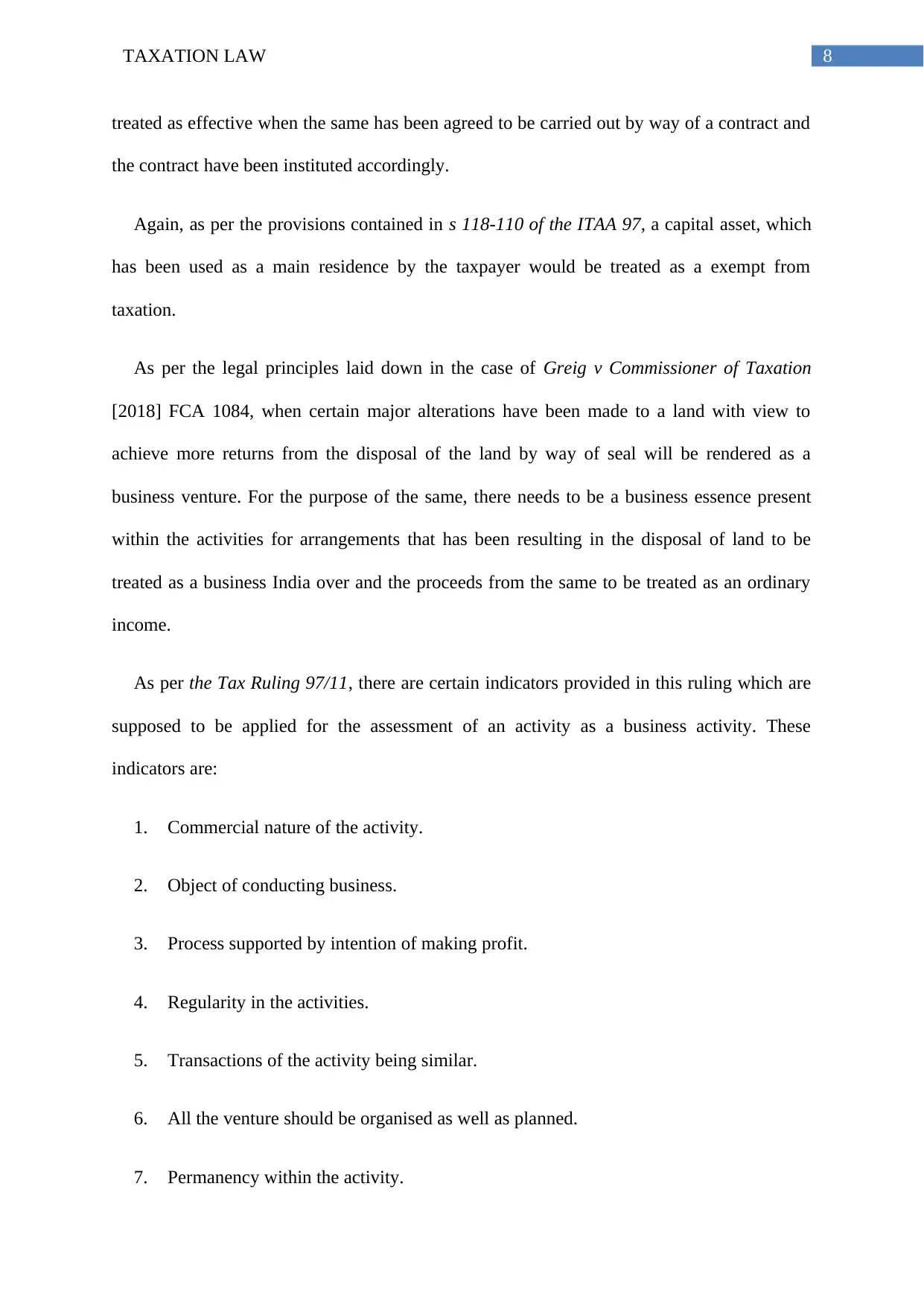
8TAXATION LAW
treated as effective when the same has been agreed to be carried out by way of a contract and
the contract have been instituted accordingly.
Again, as per the provisions contained in s 118-110 of the ITAA 97, a capital asset, which
has been used as a main residence by the taxpayer would be treated as a exempt from
taxation.
As per the legal principles laid down in the case of Greig v Commissioner of Taxation
[2018] FCA 1084, when certain major alterations have been made to a land with view to
achieve more returns from the disposal of the land by way of seal will be rendered as a
business venture. For the purpose of the same, there needs to be a business essence present
within the activities for arrangements that has been resulting in the disposal of land to be
treated as a business India over and the proceeds from the same to be treated as an ordinary
income.
As per the Tax Ruling 97/11, there are certain indicators provided in this ruling which are
supposed to be applied for the assessment of an activity as a business activity. These
indicators are:
1. Commercial nature of the activity.
2. Object of conducting business.
3. Process supported by intention of making profit.
4. Regularity in the activities.
5. Transactions of the activity being similar.
6. All the venture should be organised as well as planned.
7. Permanency within the activity.
treated as effective when the same has been agreed to be carried out by way of a contract and
the contract have been instituted accordingly.
Again, as per the provisions contained in s 118-110 of the ITAA 97, a capital asset, which
has been used as a main residence by the taxpayer would be treated as a exempt from
taxation.
As per the legal principles laid down in the case of Greig v Commissioner of Taxation
[2018] FCA 1084, when certain major alterations have been made to a land with view to
achieve more returns from the disposal of the land by way of seal will be rendered as a
business venture. For the purpose of the same, there needs to be a business essence present
within the activities for arrangements that has been resulting in the disposal of land to be
treated as a business India over and the proceeds from the same to be treated as an ordinary
income.
As per the Tax Ruling 97/11, there are certain indicators provided in this ruling which are
supposed to be applied for the assessment of an activity as a business activity. These
indicators are:
1. Commercial nature of the activity.
2. Object of conducting business.
3. Process supported by intention of making profit.
4. Regularity in the activities.
5. Transactions of the activity being similar.
6. All the venture should be organised as well as planned.
7. Permanency within the activity.
⊘ This is a preview!⊘
Do you want full access?
Subscribe today to unlock all pages.

Trusted by 1+ million students worldwide
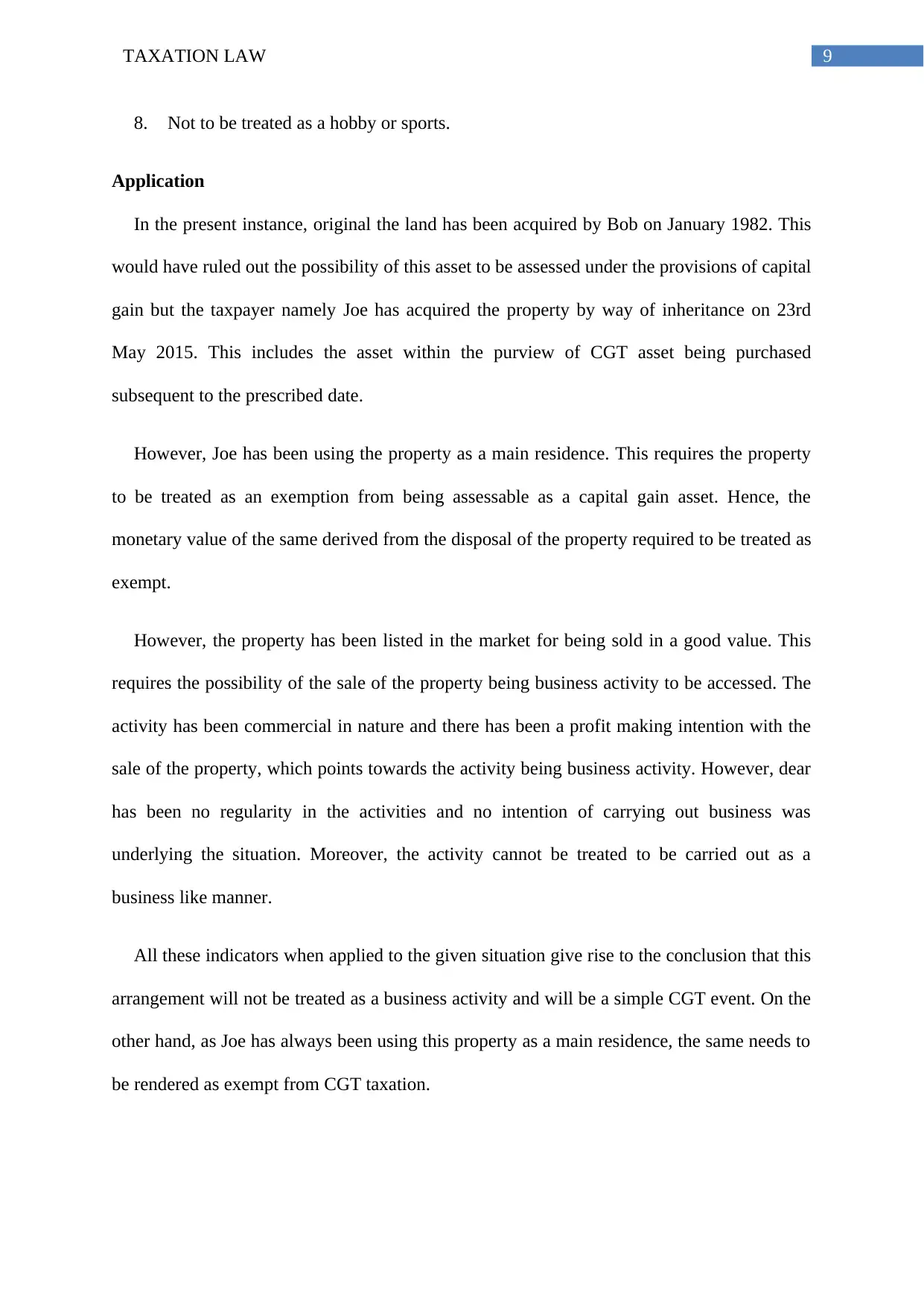
9TAXATION LAW
8. Not to be treated as a hobby or sports.
Application
In the present instance, original the land has been acquired by Bob on January 1982. This
would have ruled out the possibility of this asset to be assessed under the provisions of capital
gain but the taxpayer namely Joe has acquired the property by way of inheritance on 23rd
May 2015. This includes the asset within the purview of CGT asset being purchased
subsequent to the prescribed date.
However, Joe has been using the property as a main residence. This requires the property
to be treated as an exemption from being assessable as a capital gain asset. Hence, the
monetary value of the same derived from the disposal of the property required to be treated as
exempt.
However, the property has been listed in the market for being sold in a good value. This
requires the possibility of the sale of the property being business activity to be accessed. The
activity has been commercial in nature and there has been a profit making intention with the
sale of the property, which points towards the activity being business activity. However, dear
has been no regularity in the activities and no intention of carrying out business was
underlying the situation. Moreover, the activity cannot be treated to be carried out as a
business like manner.
All these indicators when applied to the given situation give rise to the conclusion that this
arrangement will not be treated as a business activity and will be a simple CGT event. On the
other hand, as Joe has always been using this property as a main residence, the same needs to
be rendered as exempt from CGT taxation.
8. Not to be treated as a hobby or sports.
Application
In the present instance, original the land has been acquired by Bob on January 1982. This
would have ruled out the possibility of this asset to be assessed under the provisions of capital
gain but the taxpayer namely Joe has acquired the property by way of inheritance on 23rd
May 2015. This includes the asset within the purview of CGT asset being purchased
subsequent to the prescribed date.
However, Joe has been using the property as a main residence. This requires the property
to be treated as an exemption from being assessable as a capital gain asset. Hence, the
monetary value of the same derived from the disposal of the property required to be treated as
exempt.
However, the property has been listed in the market for being sold in a good value. This
requires the possibility of the sale of the property being business activity to be accessed. The
activity has been commercial in nature and there has been a profit making intention with the
sale of the property, which points towards the activity being business activity. However, dear
has been no regularity in the activities and no intention of carrying out business was
underlying the situation. Moreover, the activity cannot be treated to be carried out as a
business like manner.
All these indicators when applied to the given situation give rise to the conclusion that this
arrangement will not be treated as a business activity and will be a simple CGT event. On the
other hand, as Joe has always been using this property as a main residence, the same needs to
be rendered as exempt from CGT taxation.
Paraphrase This Document
Need a fresh take? Get an instant paraphrase of this document with our AI Paraphraser
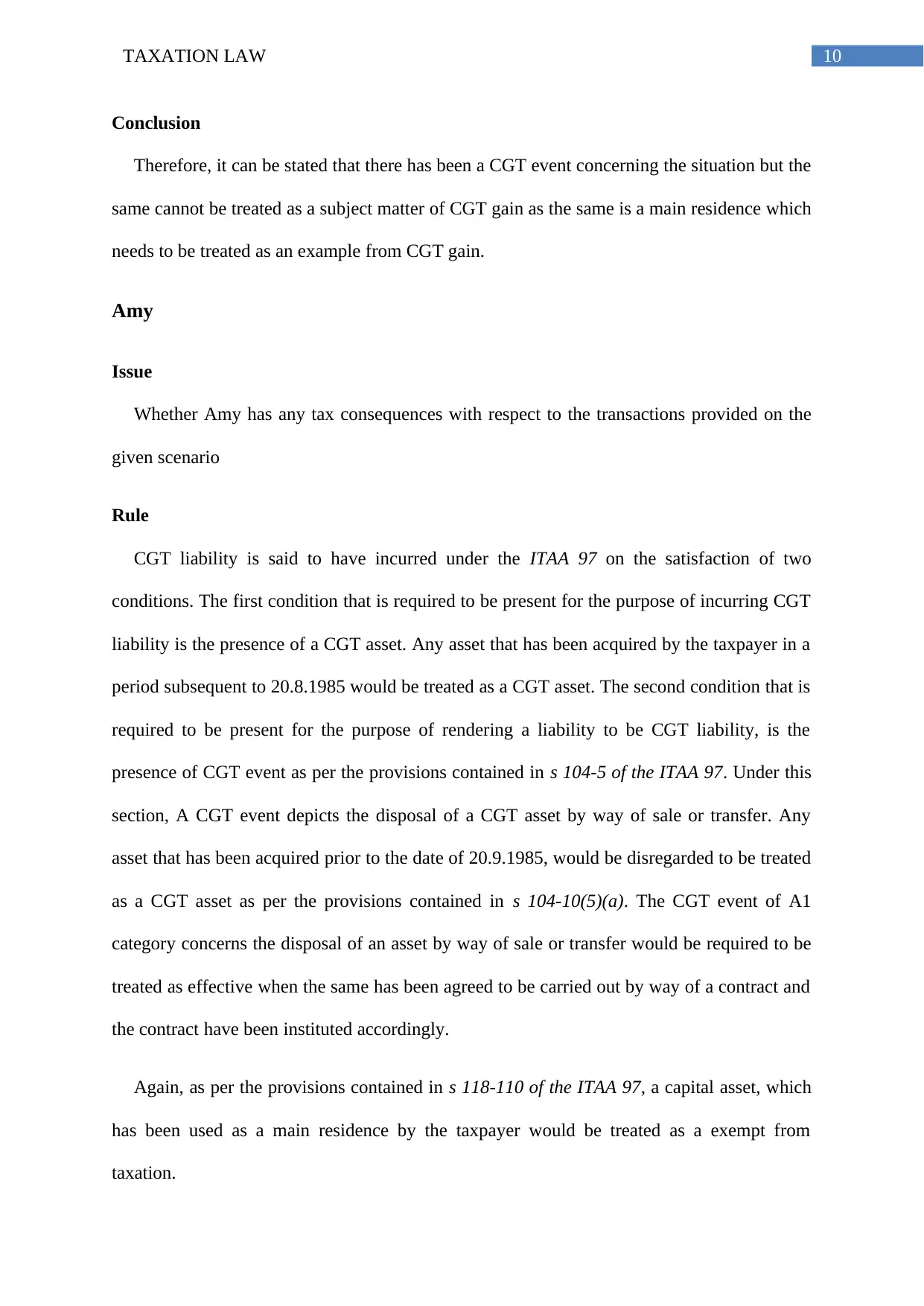
10TAXATION LAW
Conclusion
Therefore, it can be stated that there has been a CGT event concerning the situation but the
same cannot be treated as a subject matter of CGT gain as the same is a main residence which
needs to be treated as an example from CGT gain.
Amy
Issue
Whether Amy has any tax consequences with respect to the transactions provided on the
given scenario
Rule
CGT liability is said to have incurred under the ITAA 97 on the satisfaction of two
conditions. The first condition that is required to be present for the purpose of incurring CGT
liability is the presence of a CGT asset. Any asset that has been acquired by the taxpayer in a
period subsequent to 20.8.1985 would be treated as a CGT asset. The second condition that is
required to be present for the purpose of rendering a liability to be CGT liability, is the
presence of CGT event as per the provisions contained in s 104-5 of the ITAA 97. Under this
section, A CGT event depicts the disposal of a CGT asset by way of sale or transfer. Any
asset that has been acquired prior to the date of 20.9.1985, would be disregarded to be treated
as a CGT asset as per the provisions contained in s 104-10(5)(a). The CGT event of A1
category concerns the disposal of an asset by way of sale or transfer would be required to be
treated as effective when the same has been agreed to be carried out by way of a contract and
the contract have been instituted accordingly.
Again, as per the provisions contained in s 118-110 of the ITAA 97, a capital asset, which
has been used as a main residence by the taxpayer would be treated as a exempt from
taxation.
Conclusion
Therefore, it can be stated that there has been a CGT event concerning the situation but the
same cannot be treated as a subject matter of CGT gain as the same is a main residence which
needs to be treated as an example from CGT gain.
Amy
Issue
Whether Amy has any tax consequences with respect to the transactions provided on the
given scenario
Rule
CGT liability is said to have incurred under the ITAA 97 on the satisfaction of two
conditions. The first condition that is required to be present for the purpose of incurring CGT
liability is the presence of a CGT asset. Any asset that has been acquired by the taxpayer in a
period subsequent to 20.8.1985 would be treated as a CGT asset. The second condition that is
required to be present for the purpose of rendering a liability to be CGT liability, is the
presence of CGT event as per the provisions contained in s 104-5 of the ITAA 97. Under this
section, A CGT event depicts the disposal of a CGT asset by way of sale or transfer. Any
asset that has been acquired prior to the date of 20.9.1985, would be disregarded to be treated
as a CGT asset as per the provisions contained in s 104-10(5)(a). The CGT event of A1
category concerns the disposal of an asset by way of sale or transfer would be required to be
treated as effective when the same has been agreed to be carried out by way of a contract and
the contract have been instituted accordingly.
Again, as per the provisions contained in s 118-110 of the ITAA 97, a capital asset, which
has been used as a main residence by the taxpayer would be treated as a exempt from
taxation.
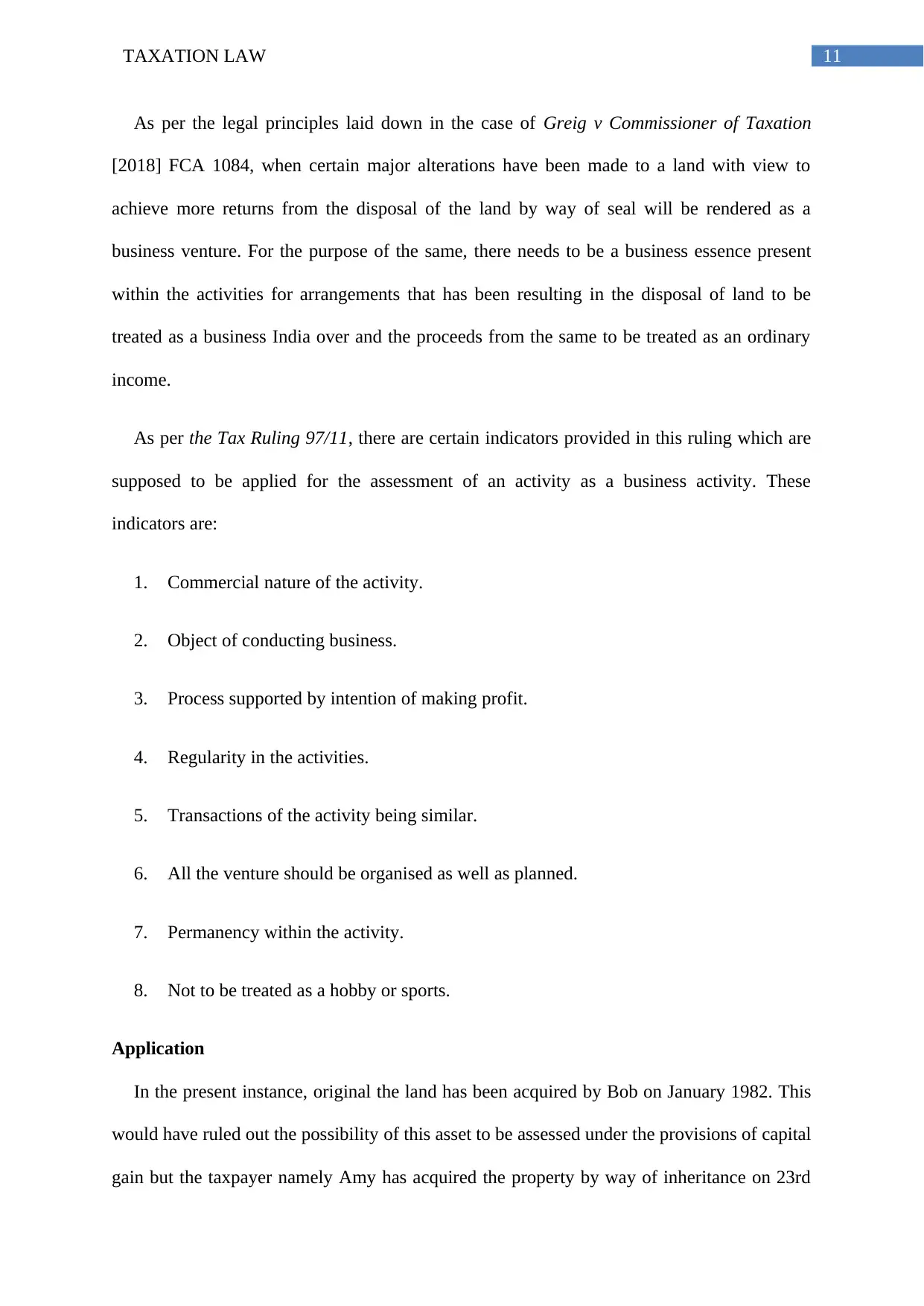
11TAXATION LAW
As per the legal principles laid down in the case of Greig v Commissioner of Taxation
[2018] FCA 1084, when certain major alterations have been made to a land with view to
achieve more returns from the disposal of the land by way of seal will be rendered as a
business venture. For the purpose of the same, there needs to be a business essence present
within the activities for arrangements that has been resulting in the disposal of land to be
treated as a business India over and the proceeds from the same to be treated as an ordinary
income.
As per the Tax Ruling 97/11, there are certain indicators provided in this ruling which are
supposed to be applied for the assessment of an activity as a business activity. These
indicators are:
1. Commercial nature of the activity.
2. Object of conducting business.
3. Process supported by intention of making profit.
4. Regularity in the activities.
5. Transactions of the activity being similar.
6. All the venture should be organised as well as planned.
7. Permanency within the activity.
8. Not to be treated as a hobby or sports.
Application
In the present instance, original the land has been acquired by Bob on January 1982. This
would have ruled out the possibility of this asset to be assessed under the provisions of capital
gain but the taxpayer namely Amy has acquired the property by way of inheritance on 23rd
As per the legal principles laid down in the case of Greig v Commissioner of Taxation
[2018] FCA 1084, when certain major alterations have been made to a land with view to
achieve more returns from the disposal of the land by way of seal will be rendered as a
business venture. For the purpose of the same, there needs to be a business essence present
within the activities for arrangements that has been resulting in the disposal of land to be
treated as a business India over and the proceeds from the same to be treated as an ordinary
income.
As per the Tax Ruling 97/11, there are certain indicators provided in this ruling which are
supposed to be applied for the assessment of an activity as a business activity. These
indicators are:
1. Commercial nature of the activity.
2. Object of conducting business.
3. Process supported by intention of making profit.
4. Regularity in the activities.
5. Transactions of the activity being similar.
6. All the venture should be organised as well as planned.
7. Permanency within the activity.
8. Not to be treated as a hobby or sports.
Application
In the present instance, original the land has been acquired by Bob on January 1982. This
would have ruled out the possibility of this asset to be assessed under the provisions of capital
gain but the taxpayer namely Amy has acquired the property by way of inheritance on 23rd
⊘ This is a preview!⊘
Do you want full access?
Subscribe today to unlock all pages.

Trusted by 1+ million students worldwide
1 out of 14
Related Documents
Your All-in-One AI-Powered Toolkit for Academic Success.
+13062052269
info@desklib.com
Available 24*7 on WhatsApp / Email
![[object Object]](/_next/static/media/star-bottom.7253800d.svg)
Unlock your academic potential
Copyright © 2020–2025 A2Z Services. All Rights Reserved. Developed and managed by ZUCOL.




